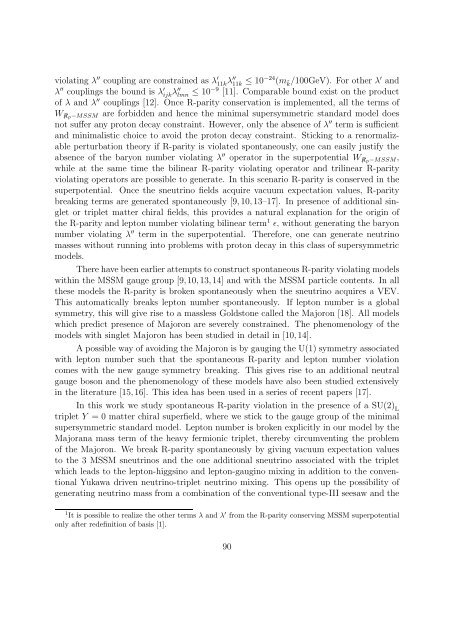PHYS08200604017 Manimala Mitra - Homi Bhabha National Institute
PHYS08200604017 Manimala Mitra - Homi Bhabha National Institute
PHYS08200604017 Manimala Mitra - Homi Bhabha National Institute
You also want an ePaper? Increase the reach of your titles
YUMPU automatically turns print PDFs into web optimized ePapers that Google loves.
violating λ ′′ coupling are constrained as λ ′ 11k λ′′ 11k ≤ 10−24 (m˜k/100GeV). For other λ ′ and<br />
λ ′′ couplings the bound is λ ′ ijk λ′′ lmn ≤ 10−9 [11]. Comparable bound exist on the product<br />
of λ and λ ′′ couplings [12]. Once R-parity conservation is implemented, all the terms of<br />
W̸Rp−MSSM are forbidden and hence the minimal supersymmetric standard model does<br />
not suffer any proton decay constraint. However, only the absence of λ ′′ term is sufficient<br />
and minimalistic choice to avoid the proton decay constraint. Sticking to a renormalizable<br />
perturbation theory if R-parity is violated spontaneously, one can easily justify the<br />
absence of the baryon number violating λ ′′ operator in the superpotential W̸Rp−MSSM,<br />
while at the same time the bilinear R-parity violating operator and trilinear R-parity<br />
violating operators are possible to generate. In this scenario R-parity is conserved in the<br />
superpotential. Once the sneutrino fields acquire vacuum expectation values, R-parity<br />
breaking terms are generated spontaneously [9,10,13–17]. In presence of additional singlet<br />
or triplet matter chiral fields, this provides a natural explanation for the origin of<br />
the R-parity and lepton number violating bilinear term 1 ǫ, without generating the baryon<br />
number violating λ ′′ term in the superpotential. Therefore, one can generate neutrino<br />
masses without running into problems with proton decay in this class of supersymmetric<br />
models.<br />
TherehavebeenearlierattemptstoconstructspontaneousR-parityviolatingmodels<br />
within the MSSM gauge group [9,10,13,14] and with the MSSM particle contents. In all<br />
these models the R-parity is broken spontaneously when the sneutrino acquires a VEV.<br />
This automatically breaks lepton number spontaneously. If lepton number is a global<br />
symmetry, this will give rise to a massless Goldstone called the Majoron [18]. All models<br />
which predict presence of Majoron are severely constrained. The phenomenology of the<br />
models with singlet Majoron has been studied in detail in [10,14].<br />
A possible way of avoiding the Majoron is by gauging the U(1) symmetry associated<br />
with lepton number such that the spontaneous R-parity and lepton number violation<br />
comes with the new gauge symmetry breaking. This gives rise to an additional neutral<br />
gauge boson and the phenomenology of these models have also been studied extensively<br />
in the literature [15,16]. This idea has been used in a series of recent papers [17].<br />
In this work we study spontaneous R-parity violation in the presence of a SU(2) L<br />
triplet Y = 0 matter chiral superfield, where we stick to the gauge group of the minimal<br />
supersymmetric standard model. Lepton number is broken explicitly in our model by the<br />
Majorana mass term of the heavy fermionic triplet, thereby circumventing the problem<br />
of the Majoron. We break R-parity spontaneously by giving vacuum expectation values<br />
to the 3 MSSM sneutrinos and the one additional sneutrino associated with the triplet<br />
which leads to the lepton-higgsino and lepton-gaugino mixing in addition to the conventional<br />
Yukawa driven neutrino-triplet neutrino mixing. This opens up the possibility of<br />
generating neutrino mass from a combination of the conventional type-III seesaw and the<br />
1 It is possible to realize the other terms λ and λ ′ from the R-parity conserving MSSM superpotential<br />
only after redefinition of basis [1].<br />
90
















